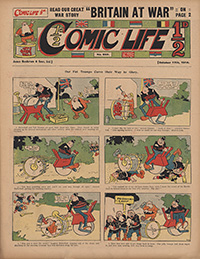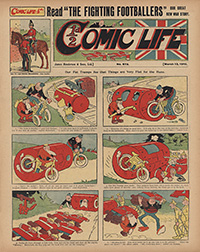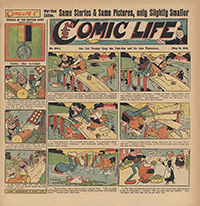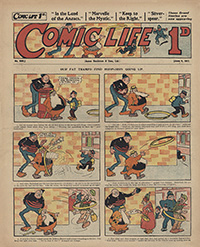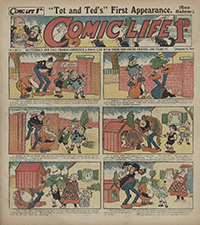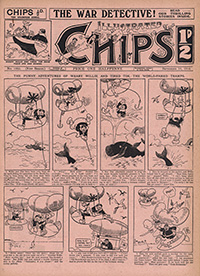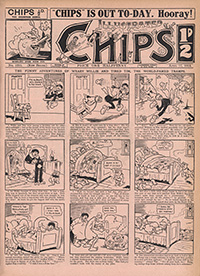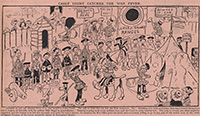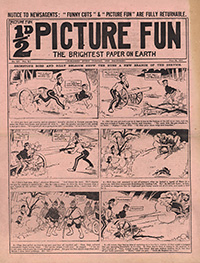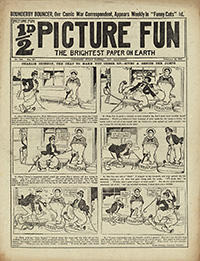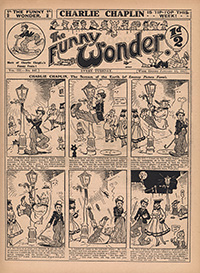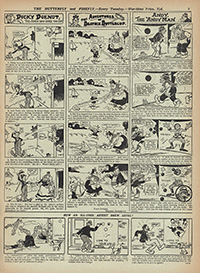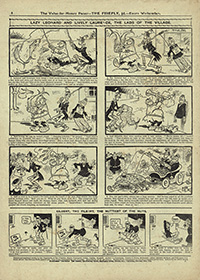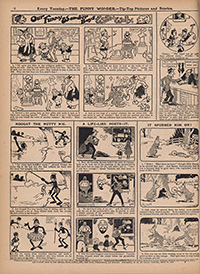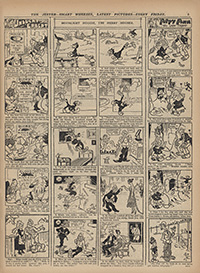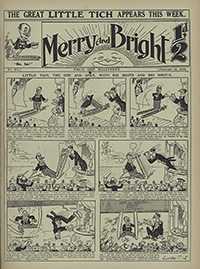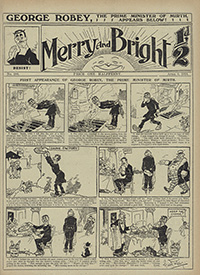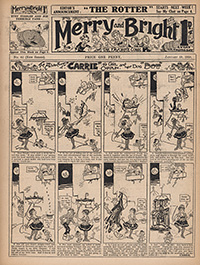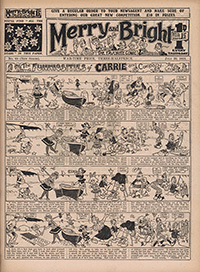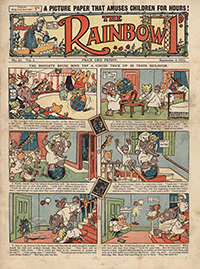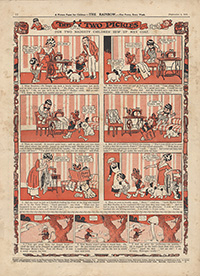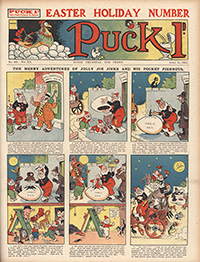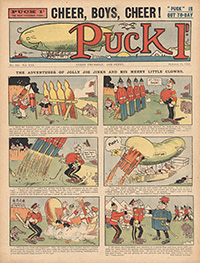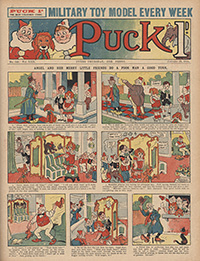Exhibit D1
Comic Life. London: James Henderson & Sons. No. 852. 17 October 1914.
Once war has been declared, tramps Tall Thomas and Butterball join active service as soon as the printing schedule allows, in the issue dated 3 October 1914. more
Exhibit D2
Comic Life. London: James Henderson & Sons. No. 873. 13 March 1915.
A few months later (compare D1), Tall Thomas and Butterball are still devising ingenious methods to defeat the enemy. more
Exhibit D3
Comic Life. London: James Henderson & Sons. No. 934. 13 May 1916.
It is spring 1916. By now there is little reference in Comic Life to the war. Tall Thomas and Butterball have returned to England to pursue their trampesque antics. more
Exhibit D4
Comic Life. London: James Henderson & Sons. No. 990. 9 June 1917.
On 14 April 1917, Comic Life reverts to its original size, but with an increased price, one penny (1d) for eight pages. more
Exhibit D5
Comic Life. London: James Henderson & Sons. No. 1021. 12 January 1918.
Now conducted by Uncle Funn, by the summer of 1917 Comic Life has completed its metamorphosis into a young children’s comic, more
Exhibit D6
Illustrated Chips. London: Fleetway House [Amalgamated Press]. No. 1255 (new series). 19 September 1914.
In their first contact with Germans, Weary Willie and Tired Tim puncture and destroy a Zeppelin. more
Exhibit D7
Illustrated Chips. London: Fleetway House [Amalgamated Press]. No.1285 (new series). 17 April 1915.
Although the decorative title with its cannon-fire reminds readers of the war, Weary Willie and Tired Tim actually spend most of the war in England. more
Exhibit D8
Illustrated Chips. London: Fleetway House [Amalgamated Press]. No. 1254 (new series). 12 September 1914.
In “Casey Court Catches the War Fever”, the boys form themselves into a Legion of Darealls, more
Exhibit D9
Picture Fun. London: Trapps, Holmes & Co. Vol. 10, no. 337. 24 July 1915.
Cover strip by an unidentified artist, featuring Brimstone Bobs and Billy Belgium more
Exhibit D10
Picture Fun. London: Trapps, Holmes & Co. Vol. 11, no. 368. 26 February 1916.
By late 1915, certainly by early 1916, most of the comics had banned facetious confrontations with German soldiers from page one, more
Exhibit D11
The Funny Wonder. London: Fleetway House [Amalgamated Press]. Vol. 3, no.147. 13 January 1917.
In the midst of the war, a new tramp emerged to take over the front page of The Funny Wonder, thereby greatly boosting its sales more
Exhibit D12
The Butterfly and Firefly. London: Fleetway House [Amalgamated Press]. No. 57 (new series). 4 May 1918.
Page 3, left, “Dicky Doenut. The Joker Who Gives You Joy”, a strip about a tramp who bears a striking resemblance to Charlie Chaplin, more
Exhibit D13
The Firefly. London: Fleetway House [Amalgamated Press]. No. 54. 26 February 1916.
Another fat-and-thin-tramp duo, and again, another wartime invention, Lazy Leonard and Lively Laurence were created in 1915 by G. M. Payne. more
Exhibit D14
The Funny Wonder. London: Fleetway House [Amalgamated Press]. Vol. 4, no. 157. 31 March 1917.
Originally a cover-page attraction until supplanted by Charlie Chaplin, “Our Funny Wonder Boys Willie & Wally” are now on the back page, more
Exhibit D15
The Jester. London: Fleetway House [Amalgamated Press]. No. 861. 4 May 1918.
The Jester described itself as “The Ideal Serio-Comic for Home and Somewhere”, “Home” being illustrated in the decorative title by a smiling young woman reading the comic at the fireside, more
Exhibit D16
Merry and Bright. London: Fleetway House [Amalgamated Press]. No. 274. 15 January 1916.
The title of this comic (commencing 1910) was probably borrowed from the popular Edwardian song “My Motter”, sung in the musical comedy The Arcadians (1909), more
Exhibit D17
Merry and Bright. London: Fleetway House [Amalgamated Press]. No. 286. 8 April 1916.
The first appearance of music hall comedian George Robey, “the Prime Minister of Mirth”, drawn by Alex Akerbladh. more
Exhibit D18
Merry and Bright. London: Fleetway House [Amalgamated Press]. No. 42 (new series). 19 January 1918.
“The Adventures of Carrie the Girl Chaplin and her Dog Dot”, drawn by George Wakefield, more
Exhibit D19
Merry and Bright. London: Fleetway House [Amalgamated Press]. No. 68 (new series). 20 July 1918.
In the chaotic “Funniosities of Carrie and Company”, Carrie is joined by other popular characters active in this comic, among them Little Tich, Sheerluck Bones, more
Exhibit D20
The Rainbow. London: Fleetway House [Amalgamated Press]. Vol. 2, no. 82. 4 September 1915.
Devised as a children’s comic in early 1914, The Rainbow kept running through two world wars, finally folding in 1956. more
Exhibit D21
The Rainbow. London: Fleetway House [Amalgamated Press]. Vol. 2, no. 82. 4 September 1915.
On the back page of The Rainbow (page 12), The Two Pickles are as “naughty” as The Bruin Boys are on page one. more
Exhibit D22
Puck. Easter Holiday Number. London: Fleetway House [Amalgamated Press]. Vol. 20, no. 507. 11 April 1914.
This pre-war special Easter number of Puck features “The Merry Adventures of Jolly Joe Jinks and his Pocket Pierrots” more
Exhibit D23
Puck. London: Fleetway House [Amalgamated Press]. Vol. 21, no. 536. 31 October 1914.
As Guy Fawkes Day approaches, the Merry Little Clowns (plus pet elephant) puncture a Zeppelin with their rockets, more
Exhibit D24
Puck. London: Fleetway House [Amalgamated Press]. Vol. 22, no. 549. 30 January 1915.
Once Jolly Joe Jinks has retired, his role as leader of the gang is taken over by a tender-hearted little girl, Angel, who with her Merry Little Friends (plus pet elephant) now cavort on the front page of Puck. more
